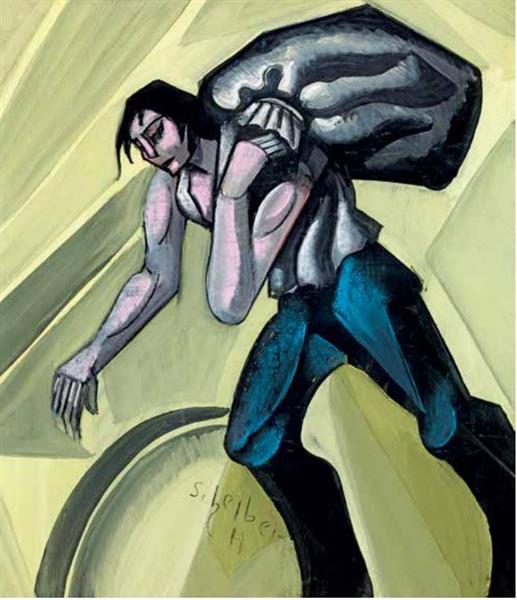Description
The painting "Zsákordó 1930" by Hugó Scheiber stands out as a significant exponent of the modernist approach that characterizes the work of this Hungarian artist. Scheiber, whose production is at the confluence of the impressionist and fauvistas currents, presents in this work an energetic and vivid representation that invites the viewer to immerse himself in a sensory world where color and shape are intertwined in a singular way.
In "Zsákhordó 1930", the artistic composition is structured by a bold use of color, where the chromatic spectrum unfolds with an intensity that evokes both natural light and the emotionality of the moment. The dominant green tones suggest a landscape in transition, possibly at dawn or at sunset, wrapped in an ethereal environment that is complemented with shadows in darker tones and nuances of blue. These chromatic elections not only generate an atmosphere of calm, but also drive a sense of movement, as if the surrounding surroundings influence the scene represented.
The work lacks human characters figuratively, allowing the spectator to direct his attention to the natural elements that seem to come alive. In this sense, Scheiber reflects a comfort when dealing with abstract elements found in nature; The trees and formations that emerge from the background are conceived almost as danceful figures that are intertwined in a visual dialogue. This abstraction and personification of the natural is a fundamental characteristic of the style of Scheiber, who often explored the connection between the human being and its environment through an approach that goes beyond the literal.
The analysis of the work also reveals a notable sense of perspective and depth. The arrangement of the elements on the canvas suggests a space that expands to the horizon, where the forms are dissolved in a nebula of soft colors. This depth use allows paint to breathe, while inviting the viewer to explore an invitation that feels both internal and external. This type of exploration is common in Scheiber's work, and aligns with the concerns of many artists of their time to create visual experiences that will evoke feelings more than representations of objective reality.
Hugó Scheiber, an artist of Hungarian origin who lived between 1873 and 1950, was influenced by the postimpressionist movement and his work is testimony of a constant search for artistic innovation. In "Zsákordó 1930", his style unfolds in a synthesis of modernity and emotional evocation. The work not only reflects a technical mastery in the application of painting, but also offers a personal vision of the natural world, creating an intimate connection between the viewer and the very essence of the landscape.
Thus, "Zsákordó 1930" is not simply a static representation, but a reflection of the interaction between art, nature and human emotions. The piece is erected as a testimony of the visual ability to communicate the subtleties of human experience, reconsidering our place in the vast tapestry of nature that surrounds us. In the whole of his work, this painting highlights as an example of Hungarian modernism, inviting future generations to explore the deep connection between art and nature, a conductive thread that still resonates in contemporary discourse.
KUADROS ©, a famous paint on your wall.
Hand-made oil painting reproductions, with the quality of professional artists and the distinctive seal of KUADROS ©.
Art reproduction service with satisfaction guarantee. If you are not completely satisfied with the replica of your painting, we refund your money 100%.

